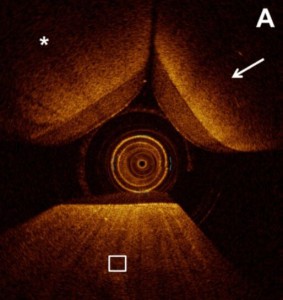Macrophagic enhancement in optical coherence tomography imaging by means of superparamagnetic iron oxide nanoparticles
Juan Luis Gutiérrez-Chico, Milosz Jaguszewski, Miguel Comesaña-Hermo, Miguel A. Correa-Duarte, Luis Mariñas-Pardo, and Manuel Hermida-Prieto
Cardiol. J. 2017, 24, 459‒466
Background:
The ability of optical coherence tomography (OCT) to visualise macrophages in vivo in coronary arteries is still controversial. We hypothesise that imaging of macrophages in OCT could be enhanced by means of superparamagnetic nanoparticles.
Methods:
We compared the optical backscattering and attenuation of cell pellets containing RAW 264.7 macrophages with those of macrophagic cell pellets labelled with very small superparamagnetic oxydised nanoparticles (VSOP) by means of light intensity analysis in OCT. The labelled macrophages were incubated with VSOP at a concentration of 1 mM Fe, corresponding to intracellular iron concentrations of 8.8 pg/cell. To study the effect of intracellular accumulation on the backscattering, VSOP dilutions without cells were also compared. OCT pullbacks of the PCR tubes containing the cell pellets were obtained and light intensity analysis was performed on raw OCT images in polar view, after normalisation by the backscattering of the PCR tube. The backscattering was estimated by the peak normalised intensity, whilst the attenuation was estimated by the number of pixels between the peak and the normalised intensity 1 (peak-to-one).
Results:
VSOP-loaded macrophages have higher backscattering than the corresponding unlabelled macrophages (peak normalised intensity 6.30 vs. 3.15) with also slightly higher attenuation (peak-to-one 61 vs. 66 pixels). The backscattering of the nanoparticles in suspension was negligible in the light intensity analysis.
Conclusions:
VSOP increase significantly the optical backscattering of macrophages in the near-infrared region, with minimal increase in signal attenuation. This finding enables the enhancement of macrophages in conventional OCT imaging with an easily implementable methodology.








